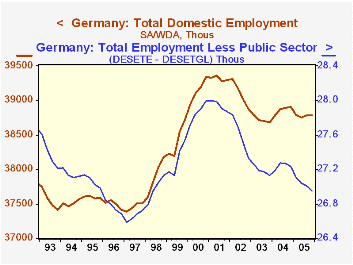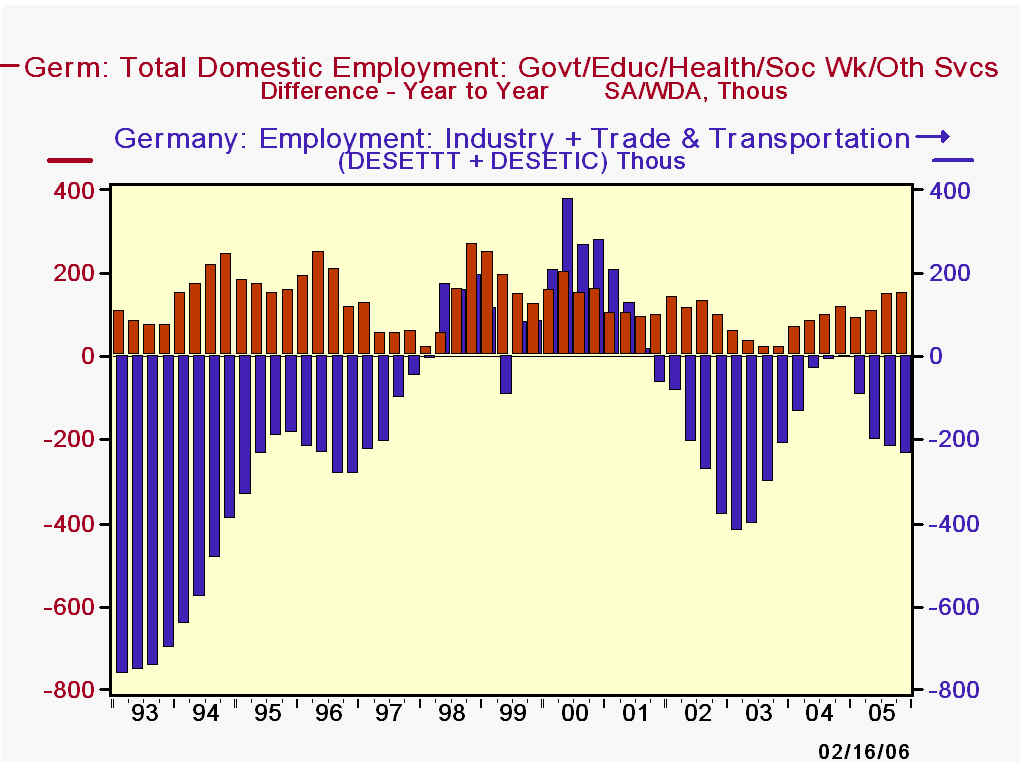 Global| Feb 16 2006
Global| Feb 16 2006German Employment Falls in Q4; Gain in Public Sector, but Private Sector Jobs Base Has Marked Erosion
Summary
Germany's Federal Statistics Office reported Q4 employment data today, classified by industry. These data are an input to German GDP data, due for release next Wednesday, February 22. Early last week (February 7), Louise Curley [...]

Germany's Federal Statistics Office reported Q4 employment data today, classified by industry. These data are an input to German GDP data, due for release next Wednesday, February 22.
Early last week (February 7), Louise Curley discussed here weakness in German industrial production for Q4 and sluggish wage performance for workers, already bringing a strike by one major union. Today's employment data give further evidence of weakening in the German economy. Total employment fell 5,000 in Q4 from Q3 and was off 0.3% from a year ago. Subtracting out government, education and other public service activities, we see that the private sector is even weaker. Jobs there decreased by 88,000 over the second half of 2005 and were off 1.0% from the year-ago period. They fell 0.8% for the year as a whole, while total employment was off 0.2% in 2005.
Jobs in industry declined 135,000 from Q4 2004 to Q4 2005 and the trade and transportation sector was down 102,000. Agriculture and construction employment also declined. Growth in finance and other business services, by contrast, showed a 76,000 increase across the year. Government and related jobs had a substantial 152,000 increase from Q4 2004. The sharp rise in public sector jobs clearly offset a good portion of the total 280,000 job loss in the private sector. At the same time, it increases the burden on private sector firms and workers to generate tax revenues with which to pay the public sector workers. So the support to the economy from added government workers comes with a cost to businesses, which are already weighed down with pressure from labor unions wanting greater compensation, as explained by Ms. Curley here last week.
| Germany (SA*, Thousands) | Q4 2005 | Q3 2005 | Q4 2004 | 2005 | 2004 | 2003 |
|---|---|---|---|---|---|---|
| Total Domestic Employment** | 38,779 | 38,784 | 38,907 | 38,779 | 38,869 | 38,719 |
| Change | -5 | +29 | -0.3% | -0.2% | +0.4% | -1.0% |
| Industry | 7,844 | 7,864 | 7,979 | 7,882 | 8,018 | 8,138 |
| Trade*** | 9,709 | 9,735 | 9,811 | 9,737 | 9,791 | 9,716 |
| Finance & Business Services | 6,443 | 6,423 | 6,369 | 6,411 | 6,309 | 6,128 |
| Government/Education/Health/Etc | 11,826 | 11,779 | 11,676 | 11,753 | 11,628 | 11,535 |
| Change | +47 | +65 | +1.3% | +1.1% | +0.8% | +0.3% |
| Total - Government/Etc | 26,953 | 27,005 | 27,231 | 27,026 | 27,241 | 27,184 |
| Change | -52 | -36 | -1.0% | -0.8% | +0.2% | -1.5% |
Carol Stone, CBE
AuthorMore in Author Profile »Carol Stone, CBE came to Haver Analytics in 2003 following more than 35 years as a financial market economist at major Wall Street financial institutions, most especially Merrill Lynch and Nomura Securities. She had broad experience in analysis and forecasting of flow-of-funds accounts, the federal budget and Federal Reserve operations. At Nomura Securities, among other duties, she developed various indicator forecasting tools and edited a daily global publication produced in London and New York for readers in Tokyo. At Haver Analytics, Carol was a member of the Research Department, aiding database managers with research and documentation efforts, as well as posting commentary on select economic reports. In addition, she conducted Ways-of-the-World, a blog on economic issues for an Episcopal-Church-affiliated website, The Geranium Farm. During her career, Carol served as an officer of the Money Marketeers and the Downtown Economists Club. She had a PhD from NYU's Stern School of Business. She lived in Brooklyn, New York, and had a weekend home on Long Island.





